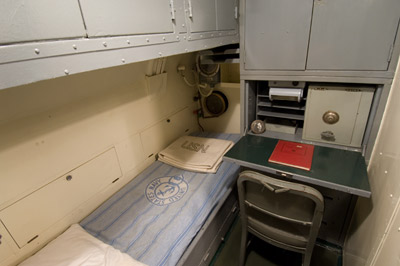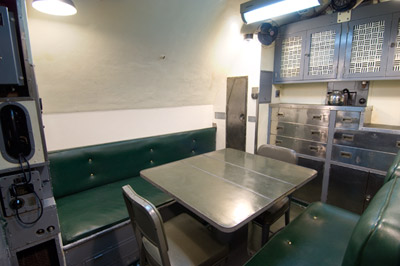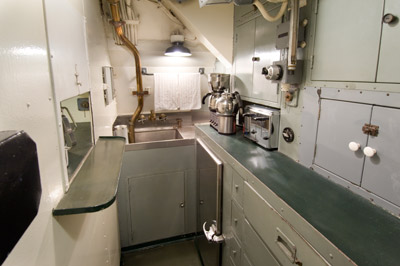|
The forward battery was also known as "officers' country". The officers' worked,
ate and slept in this area. The most senior enlisted men, chief petty officers, also berthed in this compartment but they ate in the Crew's Mess. Below this compartment is another battery compartment
like the one located under the crew's living space.
On your right as you
enter the compartment from the control room is the yeoman's office where reports were prepared and records kept. It is amazing to consider the amount of paperwork that was handled from this tiny space.
Opposite it is a stateroom for the five most senior enlisted men (the chief petty officers) affectionately known as the "goat locker". Lower
grade petty officers bunked with the rest of the enlisted men. One officers' stateroom bunked 3 men, the other two bunked 2 men each. In the wardroom an extra bunk could be fitted when needed.

See another view of the captain's stateroom.
The Commanding Officer's stateroom is just forward of the yeoman's shack. The captain was the only person aboard allowed even a little bit of privacy, cramped though it was. In addition to his bunk and storage lockers,
the captain also had a course indicator repeater, deep depth gauge, a writing
desk, and a communications system to keep in contact with the rest of the
submarine.
The relationship between officers and enlisted men was a little different in submarines than in the bigger surface ships. It was closer and relied a bit more on mutual respect and a bit less on discipline. Many factors contributed to this difference. The officers were younger and thereby closer in age to the enlisted men. There was also not much privacy for anyone aboard the boat. Even the officers staterooms are separated from the passageway only by curtains, no doors, and the crew would be moving throughout the boat at all times of day and night so the officers were not as physically separated from the crew. They ate the same food, and shared the same heightened dangers. This made it particularly difficult when there were conflicts between enlisted men and the officers, but it also made such conflicts far less common than elsewhere in the Navy.

See another view in the wardroom.
A little farther along on your left is the wardroom which served as
a mess hall, recreation room, workspace and meeting room for the officers. The ship's chronometers and charts were stored here. The officers' food was
served here from the pantry at the forward end of the wardroom by a steward's mate. Only coffee and toast were prepared in the pantry. Officers and crew dined on the same excellent food prepared in the galley.

Pampanito had 4 commanding officers during the war, 2 of
whom were in command for her 6 war patrols. Commander Paul E. Summers
commanded for 5 of her 6 patrols, and Captain Frank W. Fenno was in
command during her fourth patrol.
|